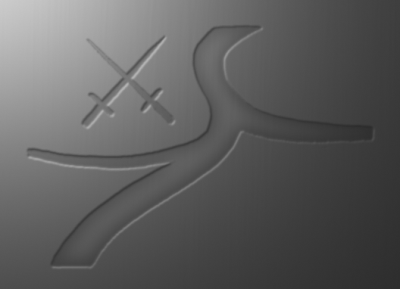Zakumeli
A precinct in the south-east of Central Redo-Iv, known for extracting minerals from the Zalzahub river and for producing high-quality blades.
Industry & Trade
Mineral Refinement
Zakumeli is built around the processing of minerals from the Zalzahub river. Metallic compounds such as iron oxides are extracted from the water in large filtering facilities. These raw materials are then transported to smelters further inland to obtain pure iron, aluminium, gold and silver. Other trace elements from the water, such as tungsten or chromium, are used in steel production. The river's water is also rich in clay. Before the discovery of harnessed crystal fire, extracting aluminium from said clay was not profitable and it was primarily used to create high-quality porcelain. Later, the industry branched out towards technical ceramics based on aluminium oxides. Said aluminium oxides are generally found in the form of finely-grained corundum. These see wide-spread use as abrasives in tools for cutting, filing and polishing.Blade Manufacturing
With access to steel, ceramics and abrasive tools, the city attracts numerous manufacturing industries. To this day, many of those are still centered around the production of blades and cutting tools. In ancient times, the town of Umel-Duza was already renowned for its skilled blacksmiths. The blades they produced were both durable and sharp, making them the ideal choice for army equipment. Consequently, the bladed weapons used by Ran-E-Zu soldiers were respected and feared all over Ranul. As warfare moved away from melee weapons, production shifted towards utility knives, kitchen cutlery and surgical tools. These industries were revived after the Final War as Zakumeli took up the legacy of its predecessor. Today, blades are made from ceramics as well since it was discovered that these stay sharp for a longer time than their metal counterparts. Ceramic knives from Zakumeli are now found in every notable kitchen on Ranul. However, as these are also more brittle, they are unlikely to replace steel blades completely.History
During the First Civilization
The original settlement, Umelta-Ib, was founded by prospectors looking for precious metals in the Zalzahub river. But not only those caught people's interest. The more frequent iron and aluminium compounds drove the development of different crafts in the area, such as blacksmithing and porcelain pottery. This allowed the settlement to grow quickly and become a major hub of resource trade under the name of Umel-Duza.During the Final War
Sitting at the heart of the Ran-E-Zu Confederation, far away from the battle front, Umel-Duza was a reliable supplier of steel, aluminium and technical ceramics. The city was bombarded by the Rilanga Union in an air raid on 3 NZR, Degmanoma 13. Large parts of the industrial infrastructure were destroyed in the process. The area became uninhabitable when the Rilanga attacked with weapons of mass destruction at the end of the Final War. Apart from the widespread destruction, both the land and the river became contaminated with radioactive fallout and chemical warfare agents.During the Era of Recovery
The settlement was rebuilt in the year 38 VZR. It was named Zakumeglik in the Rile language. Like the original city, Zakumeglik played a major role in supplying the industry around the Zugzaspo sea with the materials extracted from the Zalzahub river. In the year 536 VZR, several cities in that region were subsumed under the metropolitan area of Gulretkos Pastib. Zakumeglik became a district called Zakumeli. When the zakdengok of Redo-Iv was established in the year 744 VZR, Gulretkos Pastib was re-named to Central Redo-Iv.Natural Resources
The Zalzahub river was named after the fact that it washes various minerals down towards the Zugzaspo sea. Zakumeli's primary industry is to filter these minerals from the water and refine them.
The most frequently found materials are:
- iron oxides (mostly hematite and magnetite)
- aluminium silicates (white clay)
- aluminium oxides (corundum, including rubies and sapphires)
- gold
- silver
Alternative Name(s)
Zakumeglik, Umel-Duza
Type
District
Population
~410,000
Location under




Comments